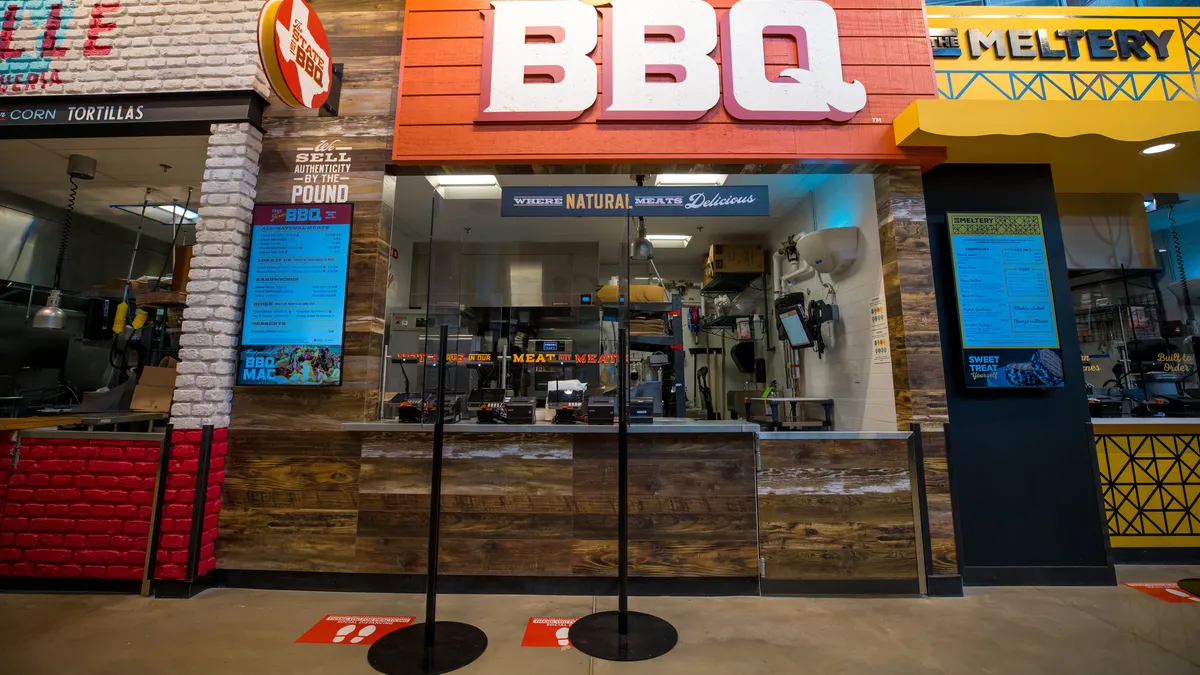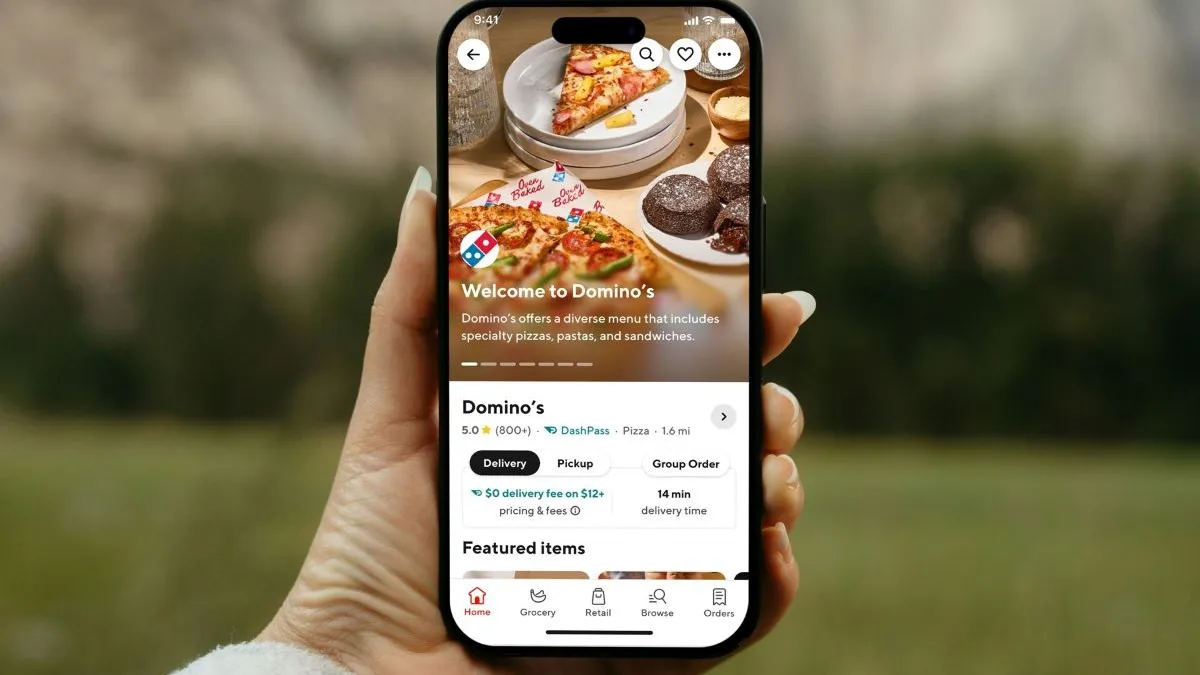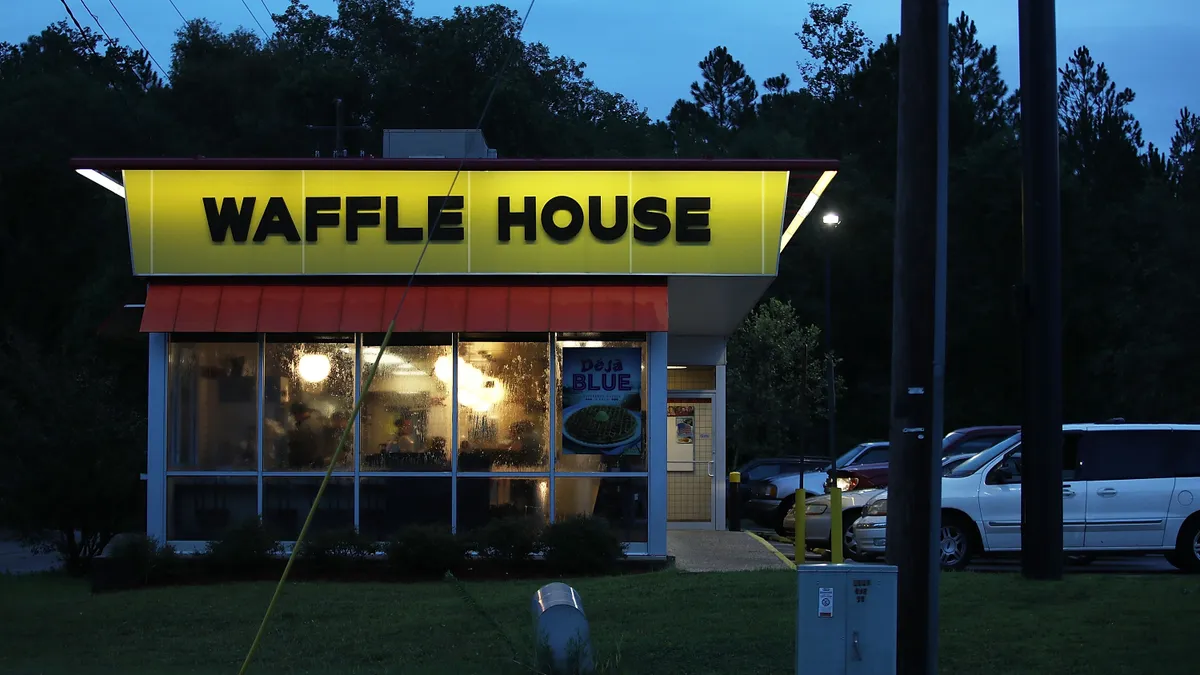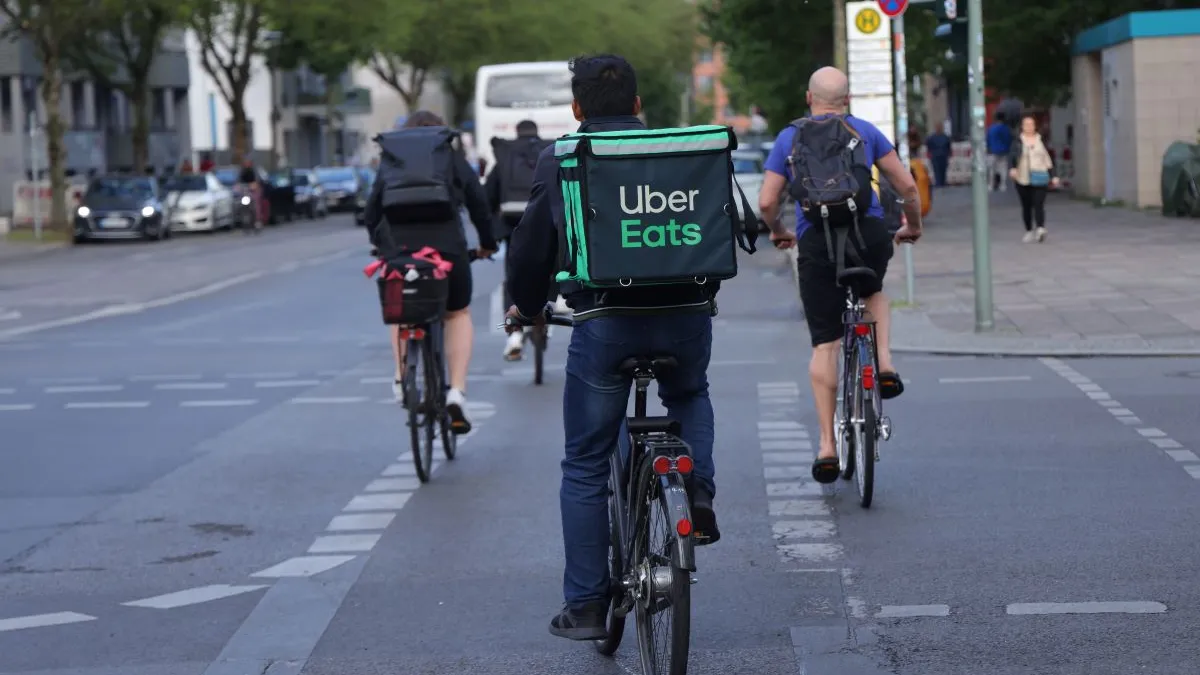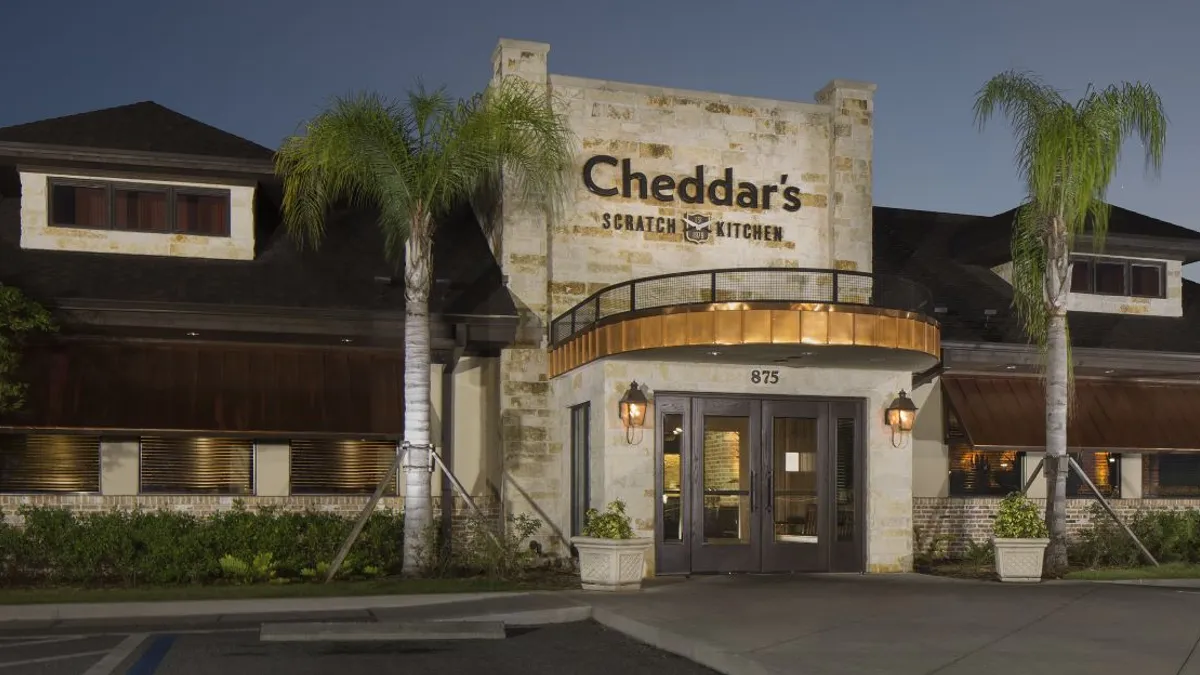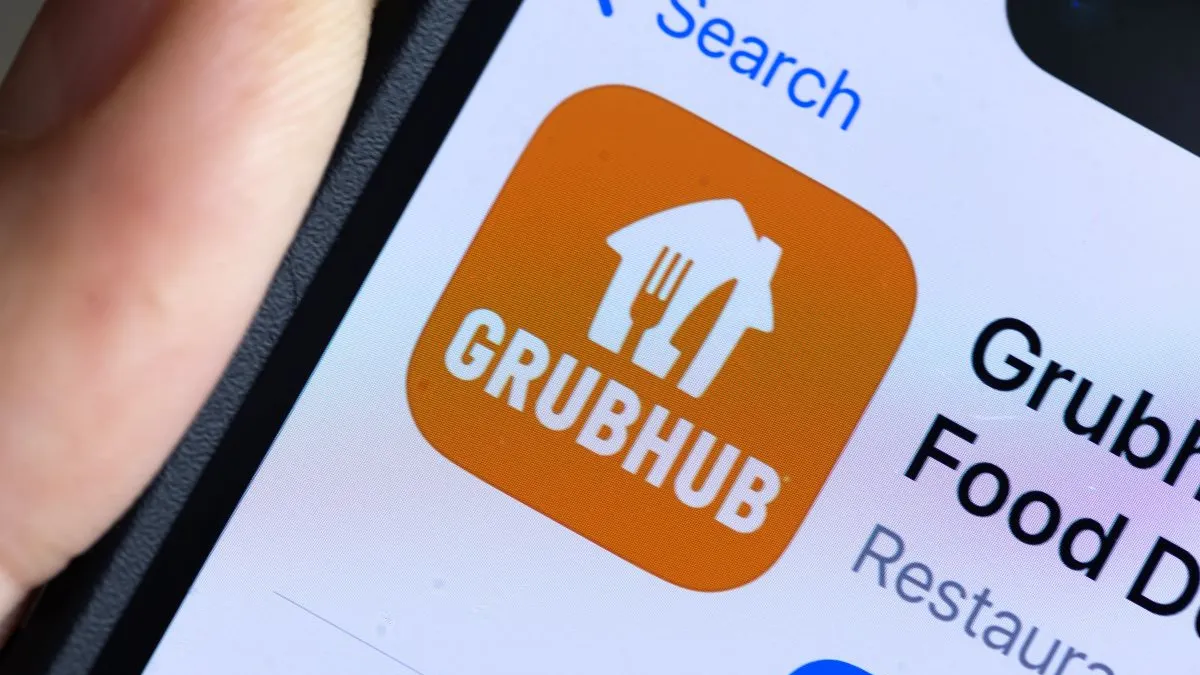When Lucky California teased the recent opening of its new California flagship store, it didn't gush about its packaged grocery selection or online shopping availability. Instead, it spotlighted The Eatery, a new takeout restaurant where shoppers can order a wide array of fresh dishes, and The Drinkery, where mixologists serve up different alcoholic and nonalcoholic beverages.
Shoppers who ventured into the 50,000-square-foot location earlier this month were invited to grab a meal or a drink — or both — and head to the outdoor patio to dine. The store also featured other you-have-to-be-here experiences, like live cooking demos and a department where shoppers can create custom cheese platters and nachos for parties.
More than a year after the coronavirus shuttered in-store restaurants and bars built to add the wow factor to their stores, grocers are eager to fully return to form. Rather than shying away from offering fresh meals and in-store dining due to lingering safety concerns, elevated at-home cooking trends and other factors, grocers are leaning into restaurants like never before.
Kevin Kelley, principal and co-founder of Shook Kelley, a design firm in the restaurant and grocery industries, said he has more in-store restaurant builds in his pipeline than he's ever had. He estimated that out of the stores his firm is designing that are set to open in two or three years, 85% to 90% have a restaurant, bar, food hall or some other sort of dining concept inside them. Most of the grocers he's working with want to build sit-down establishments, reflecting their belief that the longer shoppers linger inside a store, the more they'll spend.
Kelley attributes this high demand for in-store dining to a few factors, including grocers' need to better compete with standalone restaurants, and the influx of investment capital retailers gained in 2020. Grocers also realize that, despite their wild popularity during a global health crisis, they still need to make their stores more compelling places to shop.
"They're trying to figure out how do they attract the customer and get further away from the commodity side of the business," Kelley said.
Because restaurants are so operationally complex and expensive to run, they often struggle to turn a profit for retailers, Kelley said. Grocers need dining spots to serve up new customers and higher sales throughout the rest of the store, he noted. "A store can increase general sales by 20% to 25% by just having a restaurant," he said. "But it has to be a good restaurant."
Gelson's, an upscale California chain, had to close all of its tapas bars and sushi restaurants last year when the pandemic hit, and hasn't yet reopened them, according to chief merchandising officer John Bagan. The company has made due by offering special online meals for takeout, and by hosting virtual tasting events, like a recent one hosted by "Breaking Bad" stars Bryan Cranston and Aaron Paul for their tequila brand.
That hasn't dampened the grocer's positive outlook on in-store restaurants. Gelson's plans to open two additional tapas spots and a sushi and seafood restaurant by the end of this year, Bagan said.
"As things begin to open back up, customers seem very anxious to once again enjoy our wine and tapas bars and return to enjoying those in-person experiences," Bagan wrote in an email, noting the company plans to open up its bars with outdoor seating soon.
Aaron Ruef, director and project manager with FRCH Nelson, a Cincinnati-based design firm that's worked with restaurant operators and with Kroger, said grocers are pairing up with local restaurants to enhance the community-centric vibe at stores. Kelley also acknowledged this trend, noting smaller restaurant operators are often easier for grocers to deal with than large chains.
One way this is manifesting is with food hall concepts that place multiple establishments, often local and regional favorites, inside stores, Ruef and Kelley both said. Giant's recently opened flagship store in Philadelphia has a food hall featuring local chain Mission Taqueria, along with Saladworks. H-E-B opened a food hall in Austin, Texas, featuring five restaurants and a full-service bar, and a dining outlet at Kroger's Cincinnati flagship store houses local operators like Eli's BBQ and Queen City Whip. Schnuck Markets plans to add a food hall with three local restaurants inside a store it's remodeling in Kirkwood, Missouri.
Food halls have the allure of becoming a community gathering spot that appeals to a large cross-section of consumers. But Kelley warned that populating communities with too many food halls can strip the spots of their novel appeal.
"A city of a million people can support two to four food halls, but it can't support 20," he said.
Even as they go all-in on experience, grocers still want to be better prepared for a COVID-19 resurgence or another global health crisis. Kelley said grocers are requesting more "flexible" designs with the ability to quickly convert restaurants into e-commerce fulfillment zones and foodservice areas into merchandise displays. Monica Cole, head of the food, hospitality and agribusiness division at Wells Fargo, said restaurant and retail operators she's worked with are focused on offering seating that's socially distanced and building outdoor dining space where possible — two safety measures that in-store establishments could also adopt, she said.
"A store can increase general sales by 20% to 25% by just having a restaurant. But it has to be a good restaurant."

Kevin Kelley
Co-founder and principal, Shook Kelley
Walmart's restaurant evolution
One retailer that's making significant changes to its in-store restaurant strategy is Walmart, which leases in-store space to operators. In April, news emerged that hundreds of McDonald's locations were exiting stores due to poor sales during the pandemic, marking a steep decline for a decades-long partnership between the two large operators. At the same time, the retailer was beginning to usher new restaurant brands into its stores, like Texas bakery chain La Madeleine and Ohio-based Charleys Philly Steaks, signaling a focus more on regional brands.
Darryl Spinks, Walmart's head of retail services, said the retailer is stepping up its outreach to local and regional restaurant operators. He characterized this as a move to meet consumers' evolving tastes rather than as a way to plug in leasing holes.
"We're working on a lot of things that you'll see from us to make those tenants more aware of the space that we have available in their communities," he said.
Spinks said Walmart is also going to be more "intentional" about selecting restaurant tenants that match up with their surrounding communities. In addition to adding local operators, Walmart has recently welcomed new locations from Domino's and Taco Bell.
"Are we going to add a fifth burger restaurant inside the store when there's four of them on the parking lot? Probably not," Spinks said.
Walmart is also positioning itself on the cutting edge of digital by welcoming in ghost kitchens that prepare meals from popular brands like Quiznos, Saladworks and Nathan's Famous for online ordering or in-store takeout. The format, which Kroger has also adopted, borrows from the popular restaurant strategy that allows operators to produce a high volume of delivery meals in a dedicated prep space.
To deploy these next-generation spaces, Walmart has partnered with companies like Ghost Kitchen Brands, which is building ghost kitchens inside 29 stores in the U.S., said Marc Choy, Ghost Kitchen Brands' president. Locations typically staff two or three people and focus on a pared-down selection of menu items from more than a dozen restaurants that can be prepared in five minutes or less. Its Quiznos menu, for example, includes 16 out of the chain's full selection of 29 items. To generate awareness and boost sales, Ghost Kitchen Brands positions QR codes throughout each store where customers can scan, order food and then pick it up at the takeout window when it's ready.
Choy said restaurant operators are attracted to the ghost kitchen model because it allows them to build store density and opens up new franchise opportunities. Customers, meanwhile, like having the "virtual food court" experience in places where they like to spend time and eat. In addition to Walmart, Ghost Kitchen Brands has a location inside an upstate New York mall and is in talks with airports, hotel chains and amusement parks.
"[Walmart] saw that we have 15 different options, that our brands are flexible, we can switch brands in and out overnight," Choy said. "All that does is make the customer experience better."
Choy said Ghost Kitchen Brands is hoping to expand its deal with Walmart. Spinks declined to outline the expansion plans for ghost kitchens inside stores.
Other retailers are also making their restaurant and bar offerings available through third-party apps. Customers of Lucky California's newest store can order items from The Eatery and select drinks from The Drinkery via Uber Eats, Postmates, DoorDash and Grubhub. Saladworks, the popular full-service salad chain with locations inside Kroger, Giant and ShopRite, does about a third of its sales at these spots online through third-party meal services, said Kelly Roddy, CEO of parent company WOWorks.
Grocers typically put restaurants in their stores to encourage customers to shop before or after they order. But that sort of cross-pollination between establishments often doesn't extend to the digital space, with shoppers having to order from separate platforms for meals and groceries. Roddy said Saladworks is working with grocers to streamline everything, noting that syncing up different ordering and payment systems requires significant work.
"There's definitely a desire to do that and we're not far off from being able to do that, but it's not how the initial agreement was set up," he said.
Getting grocers and their restaurant properties synced up across channels could be a key strategic move for grocers as they seek to hold onto all the customers who grew accustomed to spending the majority of their meal dollars with stores. Cole said that as states continue to relax their distribution and e-commerce restrictions for alcohol, that will open up new opportunities for grocers to bundle food and drinks.
"I think once that concept starts to take hold more prevalently across states that you're going to see that takeout concept inside of grocery stores be even more important," she said.
Cole said grocers have opportunities to hire culinary talent and work with local restaurant brands that have struggled during the pandemic. She also sees significant upside in allowing shoppers to place takeout orders while they shop and then have the food ready when they check out.
No matter what strategy grocers pursue, she said, it should all center on drawing shoppers into their stores.
"At the end of the day it's that foot traffic that the grocers will have to have," Cole said.



